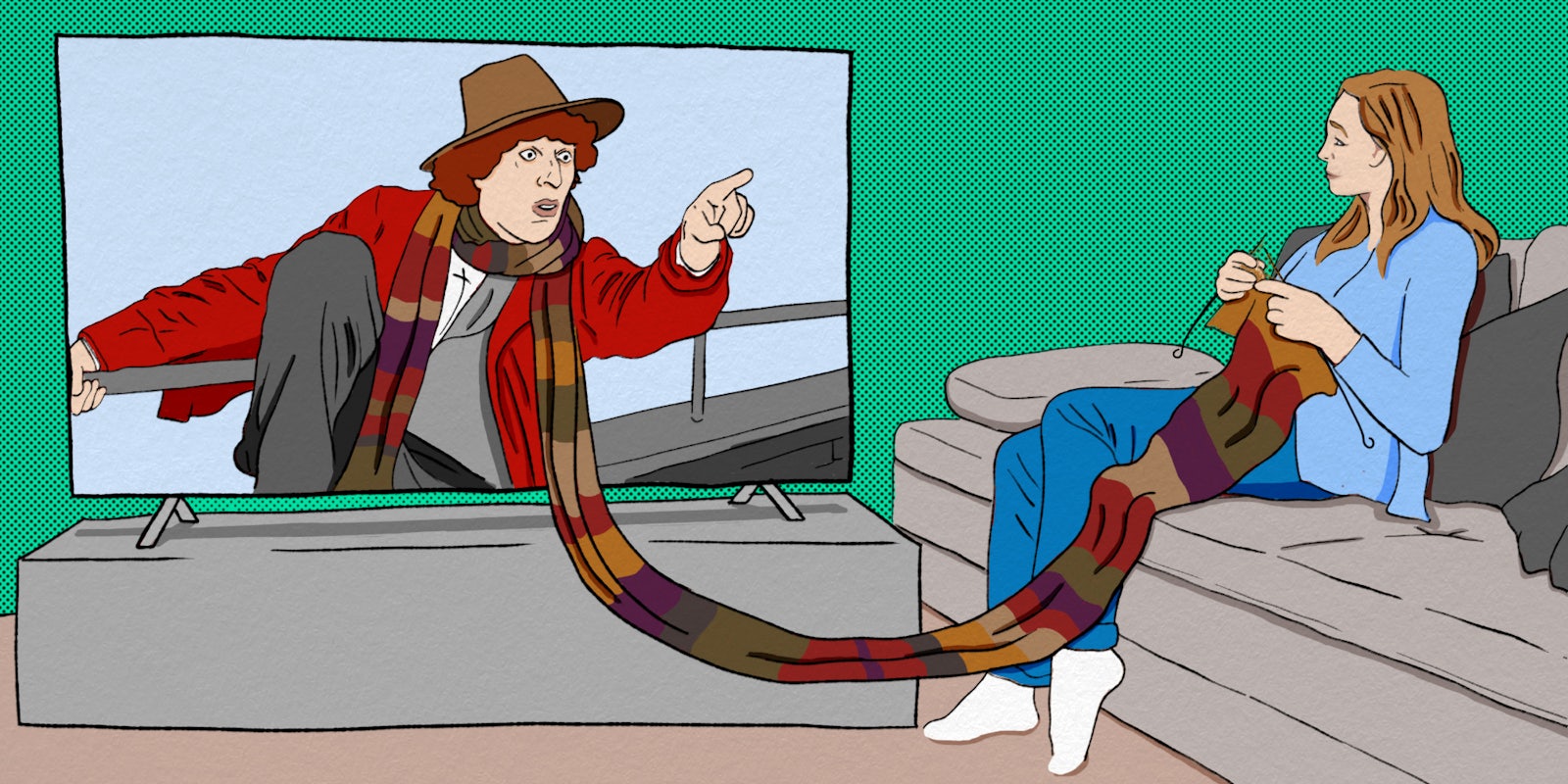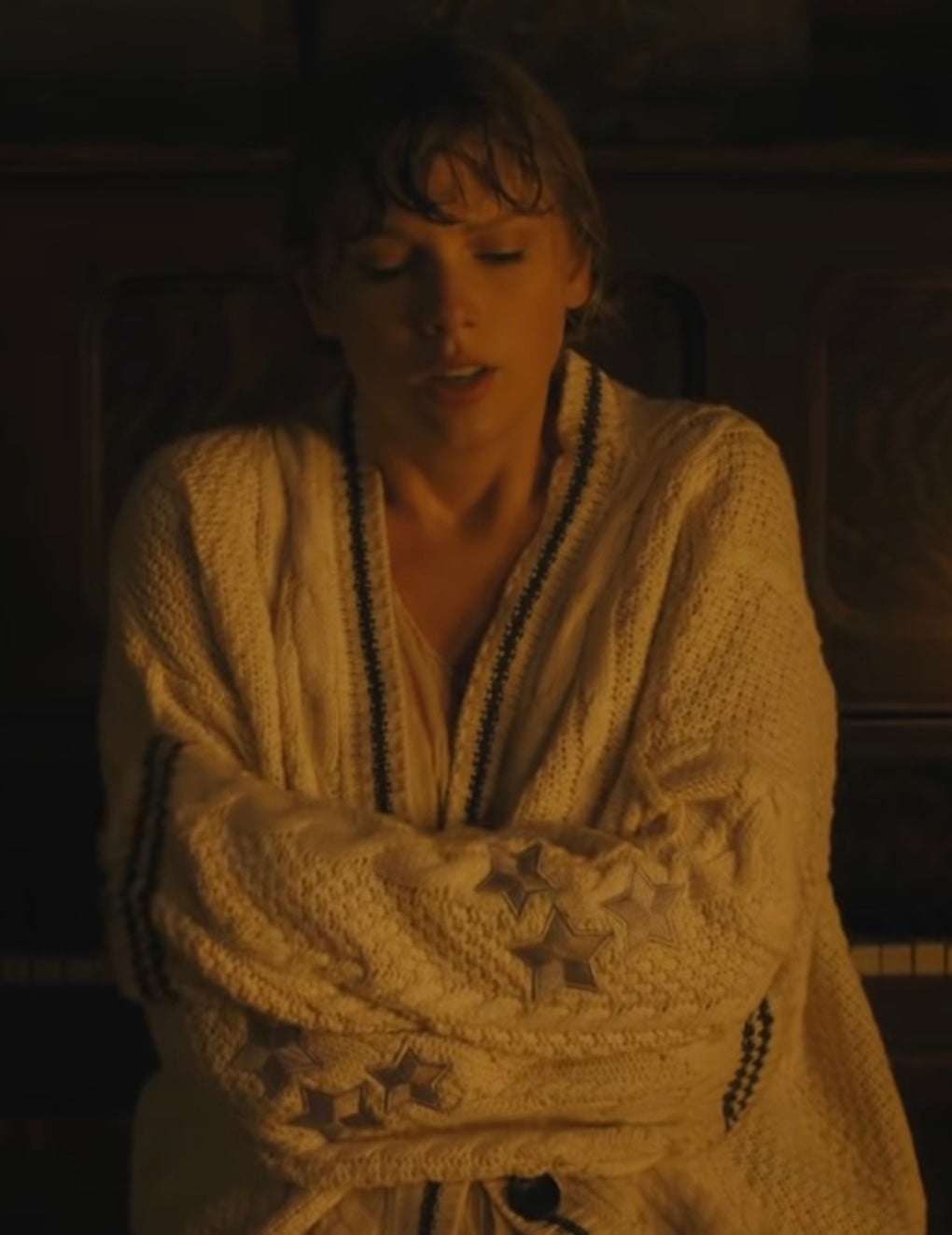In a sea of established and up-and-coming fashion designers whose outfits dominated the inauguration of Joe Biden and Kamala Harris on Jan. 20, it was, of all things, a pair of handmade mittens that practically stole the show.
If you only glanced at them, you might not have thought too much about the Fair Isle-style mittens donned by Sen. Bernie Sanders (I-Vt.). The mittens featured geometric patterns in neutral shades of brown, beige, black, and white; the palm side included hints of color with some blue and green. The mittens looked downright cozy, the sort of thing you might wear to go outside in the snow.
People quickly discovered that Jen Ellis, a teacher from Essex Junction, Vermont, created the mittens, and thousands of people sent her requests for their own pair. Ellis, unfortunately, didn’t have any left to sell. But then, in what is becoming a popular creative cycle for knitted garments seen on TV, film, and, in this case, a closely-watched national ceremony, people decided to make their own mittens. In the span of two weeks, 72 different iterations of Sanders’ mittens pattern were published on Ravelry, the biggest and most popular social network for knitters and crocheters on the internet. They included patterns for mittens, hats, cowls, and miniature mittens (for knitted and crocheted versions of Sanders himself). Several finished works have already shown up on r/knitting, a subreddit that boasts more than 362,000 members.
The process is referred to as reverse-engineering. It’s an idea that isn’t unique to crafting, but it largely works the same way as its more conventional iterations. In reverse-engineering knitwear, someone attempts to replicate the pattern of an already-existing piece of knitwear—both handmade and commercially produced—so that they and others can make that item for themselves. Think of it as having the product in your hand, breaking it down to its nuts and bolts, and then using your own instructions to build it back up.
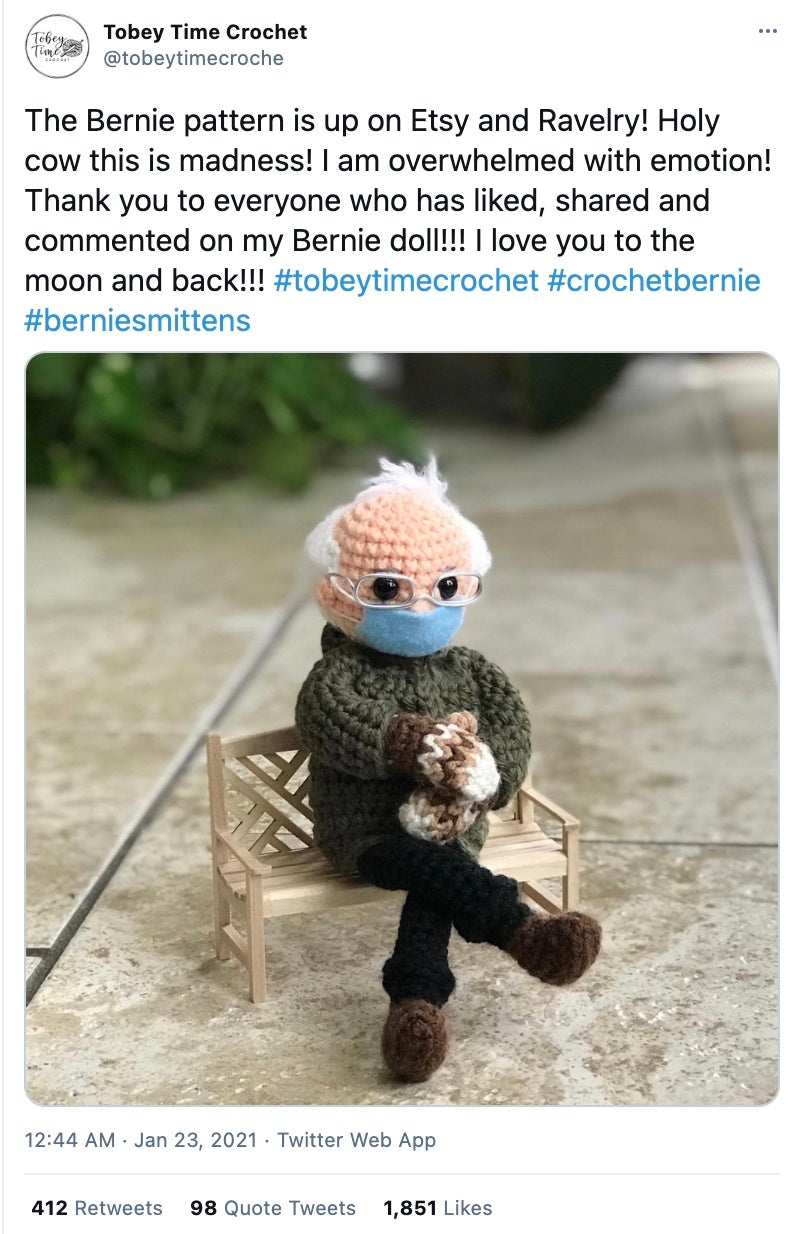
In a now-iconic photo taken by Agence France-Presse photojournalist Brandan Smialowski, Sanders sits cross-legged by his lonesome in his socially distanced seat, the mittens a visual standout next to his neutral coat and a plain medical mask. The senator didn’t seem to think much of his virality—both as a meme and as an accidental fashion inspiration. “I was just sitting there, trying to keep warm, trying to pay attention to what was going on,” Sanders told Seth Meyers on Jan. 21.
“I’m only a little surprised at the reception to Bernie’s mittens,” Caryn Shaffer, an SEO editor at the Philadelphia Inquirer, told the Daily Dot. “They’re excellent mittens. However, unlike Chris Evans playing a fictional antagonist in a movie [Knives Out] while sporting a good sweater, Bernie Sanders is a very real political figure who espouses a specific set of principles. It’s been weird to see people and companies, so averse to his anti-capitalist political positions on the campaign trail, using him as a way to advertise for their own benefit. But I guess there’s always that chance when anything goes viral.”
Shaffer has some experience with that virality. The release of Knives Out, Rian Johnson’s star-studded whodunit, in November 2019 sparked an outright fervor for the slightly damaged white Aran sweater that Ransom Drysdale, the pretentious shit-stirrer played by Chris Evans, wears for a good chunk of the film. That sweater became a standout in a film brought to life by its knitwear, and similar iterations of the Aran pattern quickly sold out in stores like L.L. Bean. After attending an early screening of the film, Shaffer, who’s been knitting for 21 years, was inspired to create her own pattern based on Evans’ Knives Out sweater. While Shaffer previously knitted the blue poncho worn by Tom Hanks’ character in Cloud Atlas for a cousin, it was the first time she was compelled to figure out a piece for herself.
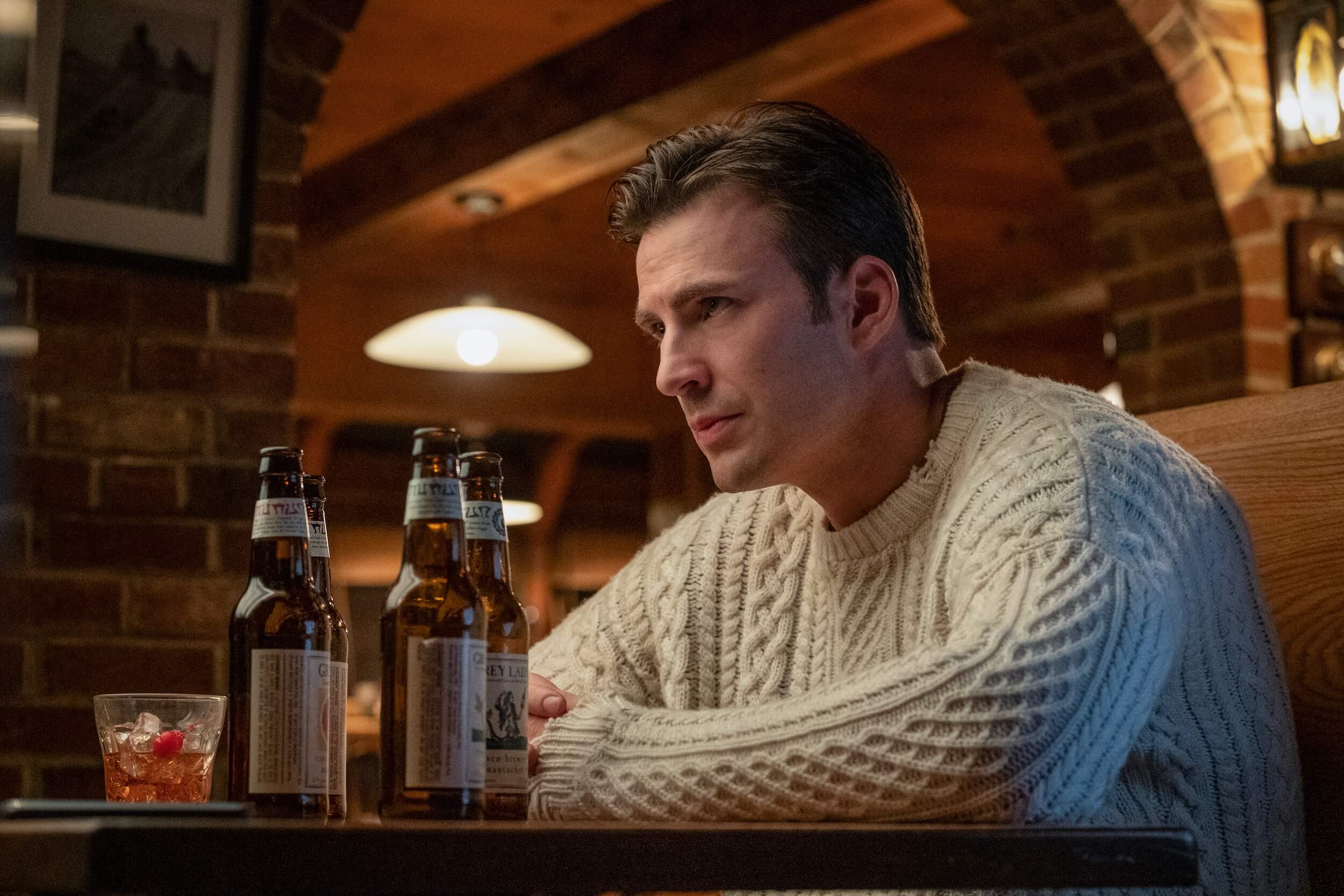
Reverse-engineered knitwear goes well beyond Bernie Sanders and Knives Out; the possibilities are limitless. Reverse-engineered patterns could be everything from a popular beanie and a resurgence of one of Princess Diana’s most famous sweaters from the ’80s after it was featured on The Crown’s latest season to yes, even a cable-knit sweater worn by a random alien in a galaxy far, far away. It can (depending on the type of yarn) be more affordable than buying the item yourself and often far more rewarding. And while those mittens and the Knives Out sweater are only recent examples of the phenomenon, it’s a long and storied fandom tradition dating back decades that, for many, can easily double as a gateway to crafting or picking up a new skill. In some cases, knitting is even a gateway to fandom. And it’s also only a matter of time before the next big piece of knitwear kicks things off again.
Casting on
Tori Bryan, the communications director at Mischief Management (which produces fan events), learned to knit when she was 8. But when she wanted to make the Weasley sweater from the Harry Potter films, she knew she had to work her way up to it and taught herself other techniques before tackling the sweater. (She’s since made 10 different Weasley sweaters for all different ages.) She also wanted to make a Hogwarts scarf but couldn’t find the right color to replicate the bronze of Ravenclaw’s House colors in the books.
“Hogwarts Houses were (and are) such an identity marker and Harry Potter was such a phenomenon, especially as the films were coming to an end, that you wanted to be able to really wear your love of the thing,” Bryan explained to the Daily Dot. “But any time I would find house merch, especially clothes, I was always frustrated with a big logo stuck somewhere on it that ruined the suspension of disbelief that came with decking yourself out like a Hogwarts student. I wanted it to feel real, not like something I had picked up at a store.”
Tanis Gray, a knitwear educator, author, and designer, has been knitting for 32 years, but her two most recent books—Harry Potter: Knitting Magic and Star Wars: Knitting the Galaxy—dive deep into fandom knitting by tapping into two of the biggest franchises out there. These books, which included a mix of replica and inspired-by knitwear, highlight just how differently the approaches to reverse-engineering knitwear can be.
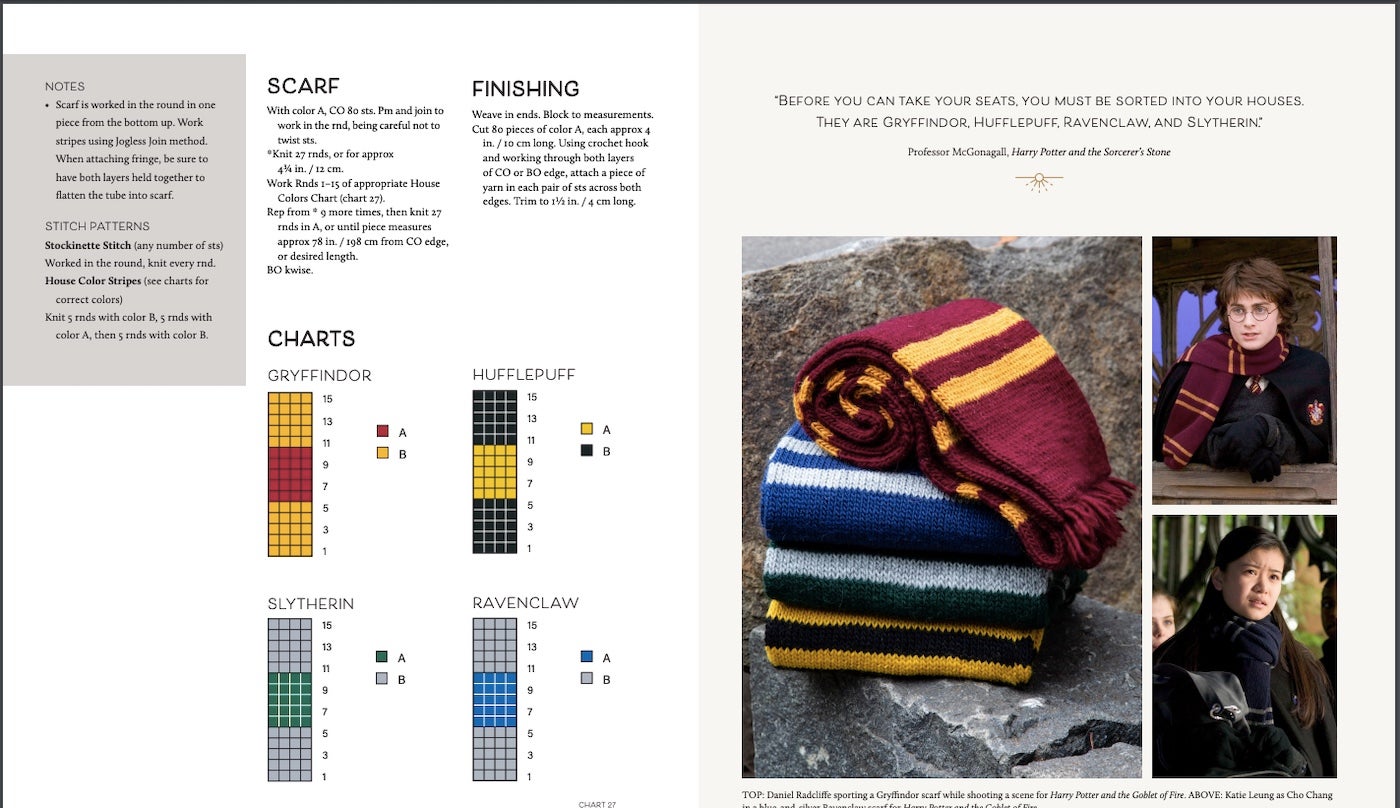
On one hand, you have the Harry Potter franchise, which is full of knitwear. In the movies, the Hogwarts uniform provided warmth in a wintry Scotland setting with scarves (both the early color-block model and the sleeker version that’s been used since Prisoner of Azkaban), and cardigans are a constant as long as Harry attends Hogwarts. Every Christmas, Molly Weasley knits lumpy sweaters for all of her children that are clearly made from a place of love; starting in Sorcerer’s Stone, Molly also knits one for Harry, an indication as any that he’s as much a part of her family as her children. But knitwear is also generally a common costume piece in Harry Potter, whether it’s one of Hermione Granger’s slouchy hats, the cardigans the Weasleys wear in the Muggle world, or even a pink scarf in the shape of a cat that Dolores Umbridge wears at one point. Fan-made patterns for some of those items (particularly the Hogwarts scarf and Weasley sweater) have been circulating online for decades, well before Knitting Magic’s publication in 2020.
On the other hand, you have Star Wars, which didn’t canonically have knitwear until very recently. The replica costumes in Knitting the Galaxy—such as Leia Organa’s Hoth snow vest in Empire Strikes Back, Padmé’s white battle wrap from Attack of the Clones, and Rey’s Resistance vest and arm wraps from The Last Jedi—aren’t based on actual pieces of knitwear.
“Most things can be translated into knitwear with a little imagination, a lot of math, trial and error, and a sense of adventure,” Gray said. “The right fiber is also very important. A thinner silk blend will have a much different drape to it than a thick rustic wool, and this matters when you’re trying to replicate something, for example, worn by Padmé [Amidala], who wears a lot of drapey fabrics. My mind is a knitter’s mind, so I’m always thinking about how things can be translated into knitwear, regardless of its original material. Some things translate fairly easily into knitwear, but other things can be quite challenging to make work.”
But as The Mandalorian proved just a few months ago, you don’t need something completely magical for a piece of knitwear to leave its mark. Sometimes, all it takes is a really good sweater to be on-screen long enough to screenshot it, which is exactly what happened when a random Mon Calamari dock worker showed up in a blue cable-knit sweater under a pair of overalls. The fervor around The Mandalorian’s key sweater didn’t particularly surprise Gray, who noted that “superstar sweaters pop up every now and then and always cause a stir.”
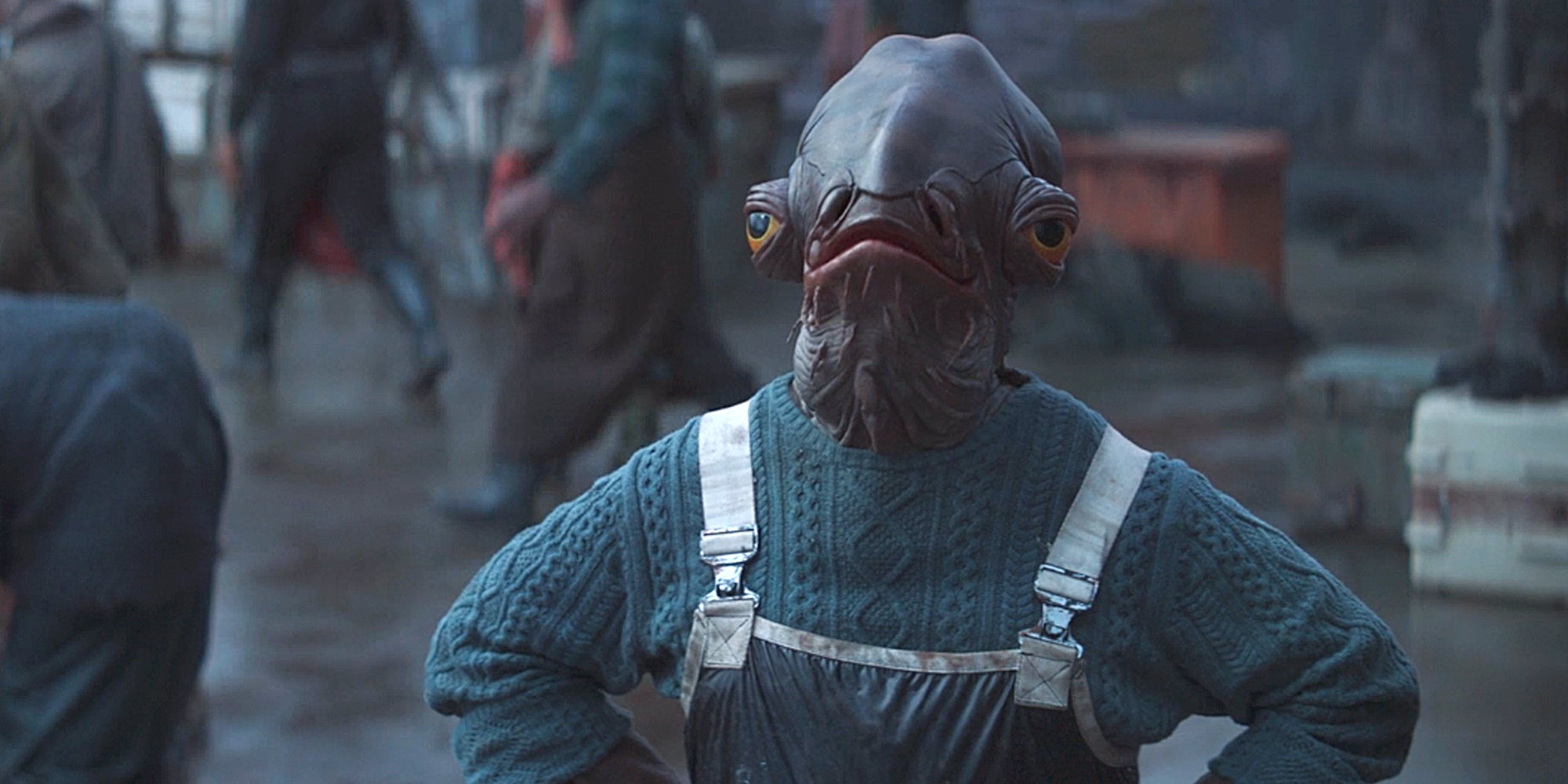
“Star Wars exists in this far-off futuristic realm and is beloved by so many,” she added. “To find a similarity between our world and their world would naturally create excitement. I lecture frequently about the history of knitting and [how] fisherman often worn cabled sweaters, so to see an alien fish wearing a fisherman’s sweater made me wonder if someone in wardrobe was being cheeky, or it was just a coincidence! I loved that he was wearing it and it created a conversation.”
It’s not always just the knit itself; sometimes, who’s wearing it helps make it iconic. As Shaffer notes in regards to Evans’ Knives Out sweater, it might be “an impressive piece on its own, but I’m sure it helped that Chris Evans, a recognizable and beloved actor, was wearing it.”
The fabrics of space and time over time
For so many of us, one of our first encounters with cinematic knitwear and the impression it leaves with us likely happened well before we started to explore our own fan sensibilities.
From 1968 until 2001, Fred Rogers, the host and mastermind behind the PBS children’s program that was such a quintessential part of our childhoods, would begin every episode of Mister Rogers’ Neighborhood with standard routine. He entered the house, took off his suit jacket and dress shoes, put them away, and slipped on a pair of sneakers and a cozy cardigan that zipped up to hang out with you and all of his friends. His repeated daily routine “offered a sense of security,” the Fred Rogers Company’s Hedda Sharapan wrote in March 2014, (according to Rewire).
Rogers’ mother, Nancy McFeely Rogers, famously knitted those sweaters (Rogers said she knitted at least once a month), and one of those zippered cardigans ended up in the Smithsonian’s Museum of American History, a donation made by Rogers himself in 1984. But even after his mother’s death and the deterioration of those original sweaters, the staff on Mister Rogers’ Neighborhood scrambled to find similar-looking cardigans to keep the routine going.
For others, especially in the U.K., one of those early introductions to famous knitwear was Doctor Who in the form of the show’s most iconic costume piece in its 57-year (and counting) history: Tom Baker’s ridiculously long, multicolored, striped scarf. We’ve seen other Doctor Who knitwear like Sylvester McCoy’s question mark vest or other scarves like Jodie Whittaker’s rainbow scarf in the 2019 New Year’s Day special, but they can’t compete with Baker’s scarf, which has enraptured fans for over 43 years.
First introduced in the Doctor Who serial “Robot” in December 1974, the origins of the scarf, a colorful monstrosity that initially measured out to be 12 feet long, is now the stuff of legend. Appearing in print as far back as Doctor Who Magazine #55 in August 1981, the story is almost Doctor Who-esque in its telling. As he put the Fourth Doctor’s costume together, costume designer James Acheson had wanted to put Baker in a “garishly coloured scarf” but he didn’t tell the knitter how long the scarf should be.
“The scarf was a happy accident,” Baker explained in the special Doctor Who: The Doctors Revisited. “Jim bought a truckload of wool and sent it out to a woman called Begonia Pope. She just used up all the wool. She, you know, just kept knitting.”
If you Google “Doctor Who scarf pattern,” you’ll find several articles from sites like Open Culture and Tor that showcase scans of several patterns from the 1980s—some of which were as simple as listing which colors were used and how many rows to knit them for—that fans said they received from the BBC after requesting the pattern for Baker’s scarf. There’s even a website that has a pattern for just about every iteration of Baker’s scarf that appeared during his seven-year run on the show.
“[Doctor Who producer] John Nathan-Turner was very kind to respond to as many fan letters as he could,” Gene Fender of doctorwhoscarf.com told Doctor Who Magazine in May 2018. “He must’ve sent out countless copies and took care to sign the BBC letterhead.”
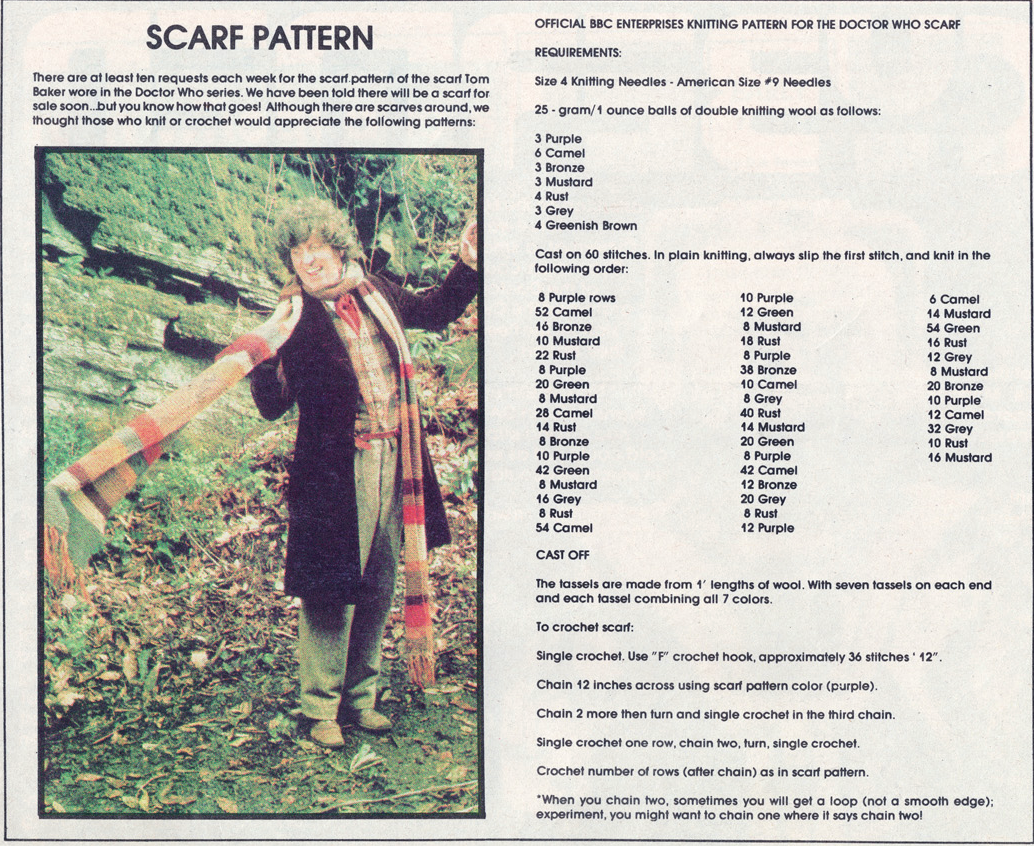
In the Whovian Times, a 20-issue Doctor Who newsletter that was published throughout much of the ’80s by the Doctor Who Fan Club of America, the scarf was a semi-frequent topic of discussion. Volume 3 included a call to “volunteers ‘who’ would like to do some knitting or crocheting for extra money” to help fill out scarf commissions. By Volume 10, which was published in 1984, the Whovian Times published the pattern for anyone to access, noting that “There are at least ten requests each week for the scarf pattern of the scarf Tom Baker wore in the Doctor Who series.”
What makes the scarf so iconic? As Aym Phoenix, a communications officer at the University of Oxford and crafter who hosts the Doctor Who podcast Reversing Polarity, said, the scarf is “something unusual, eye-catching, unexpected, but worn by the actor with complete confidence and no acknowledgment of how silly it is.”
“It’s also kind of emblematic of the silliness of the show,” they told the Daily Dot. “I think you can also see a lot of that with the Thirteenth Doctor’s costume, too—the stripy top is an easy item to wear on its own, but with the long coat and the yellow suspenders it, becomes a cohesive outfit. A similar thing happened with the Eleventh Doctor and the fez.”
Not every show and film has been as friendly with some of these efforts. At one point in 2013, Fox attempted to crack down on Firefly fans from selling their own versions of Jayne Cobb’s bright orange and yellow hat on Etsy. But in a case that went far beyond fandom, Guðrun & Guðrun, the Faroe Islands brand behind Sarah Lund’s famous vón star sweater from The Killing (which made waves both in Denmark and when it aired in the U.K. years later) lost its legal battle to stop a Danish brand from selling the same sweater at a cheaper price in 2014 after suing for copyright infringement.
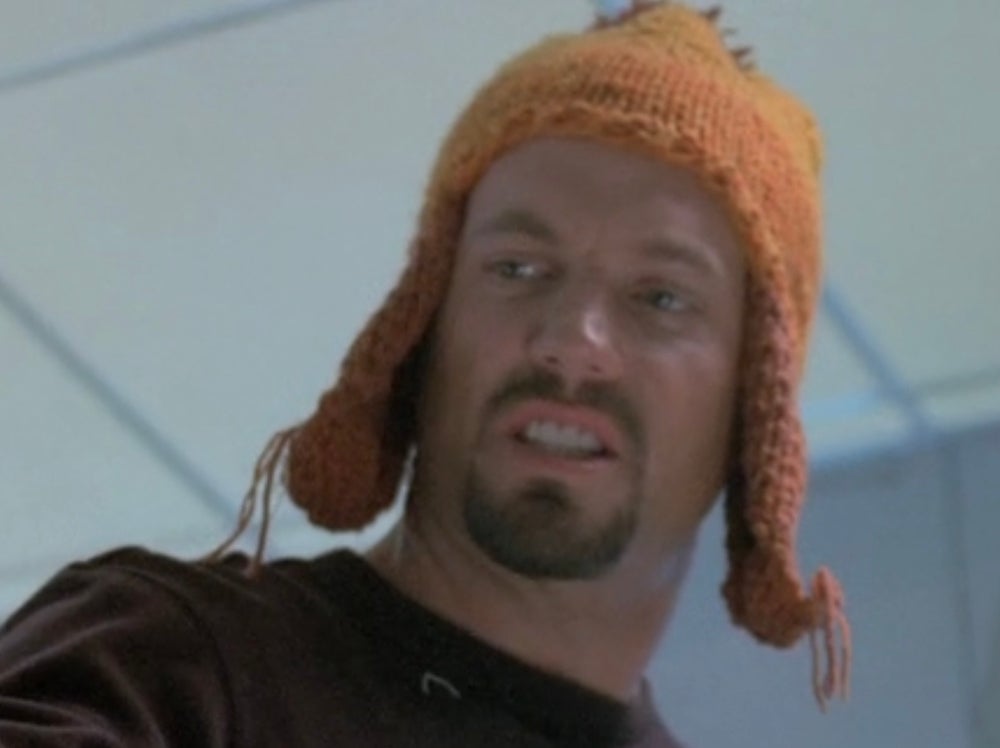
Jayne Cobb’s hat
The knitted hat wins over Firefly fans after it appears in “The Message”.
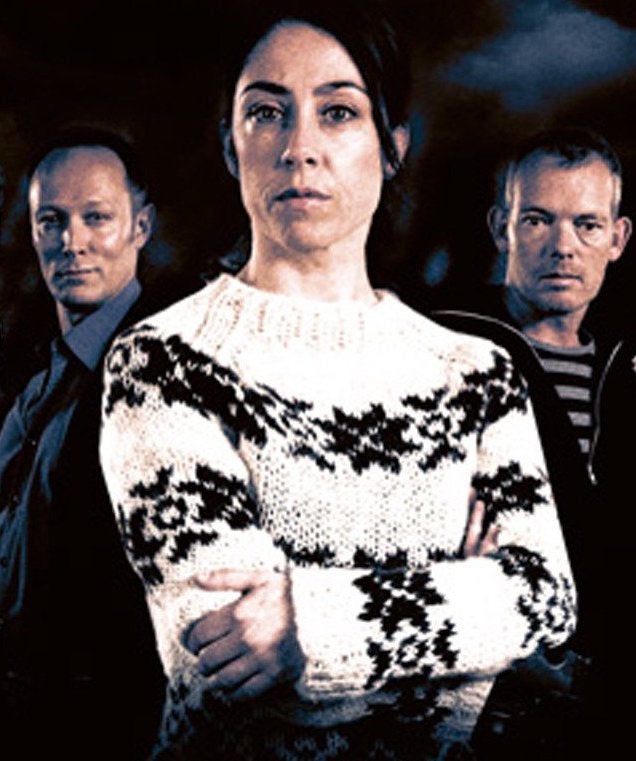
‘The Killing’ sweater
Sarah Lund’s sweater goes viral after appearing in the Danish version of the series.
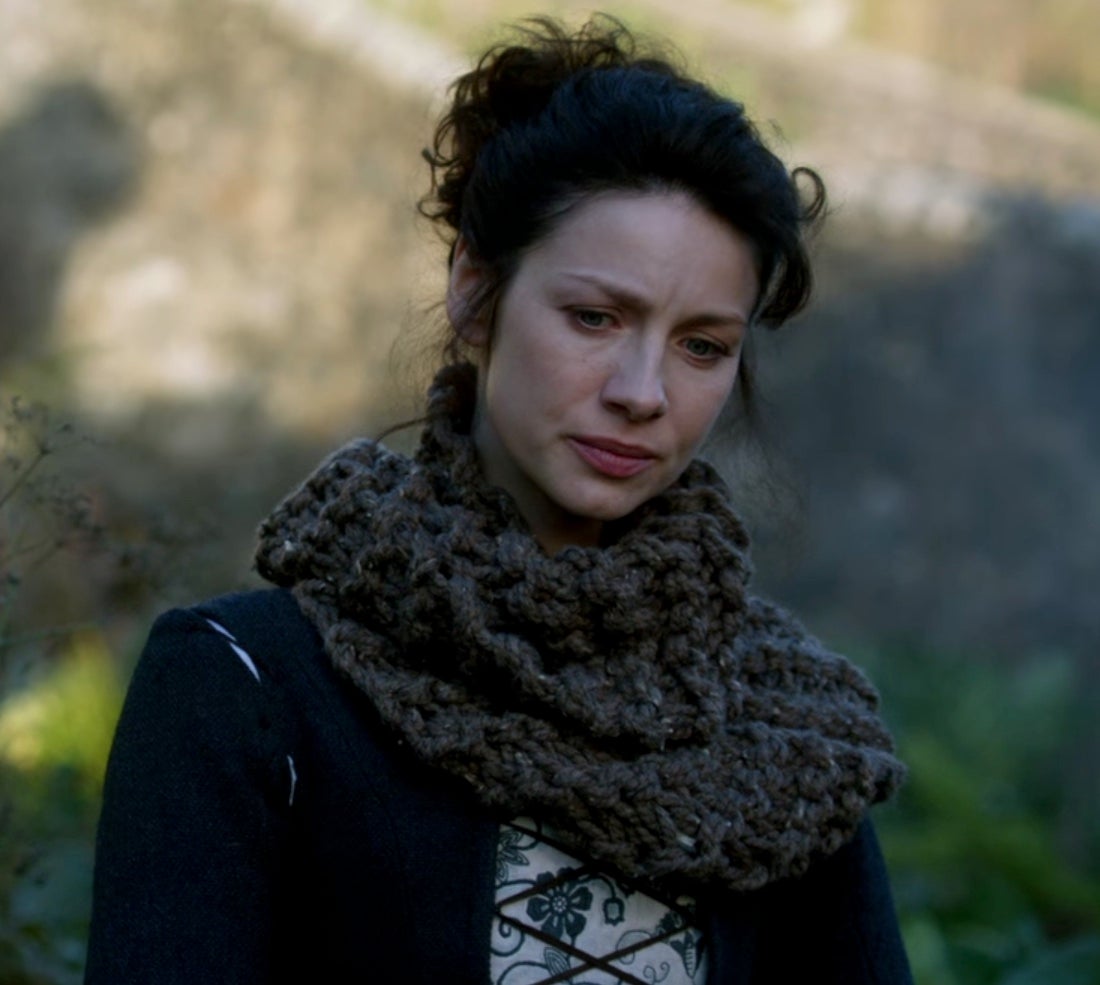
Claire’s cowl
The coveted cowl shows up in Outlander’s third episode.
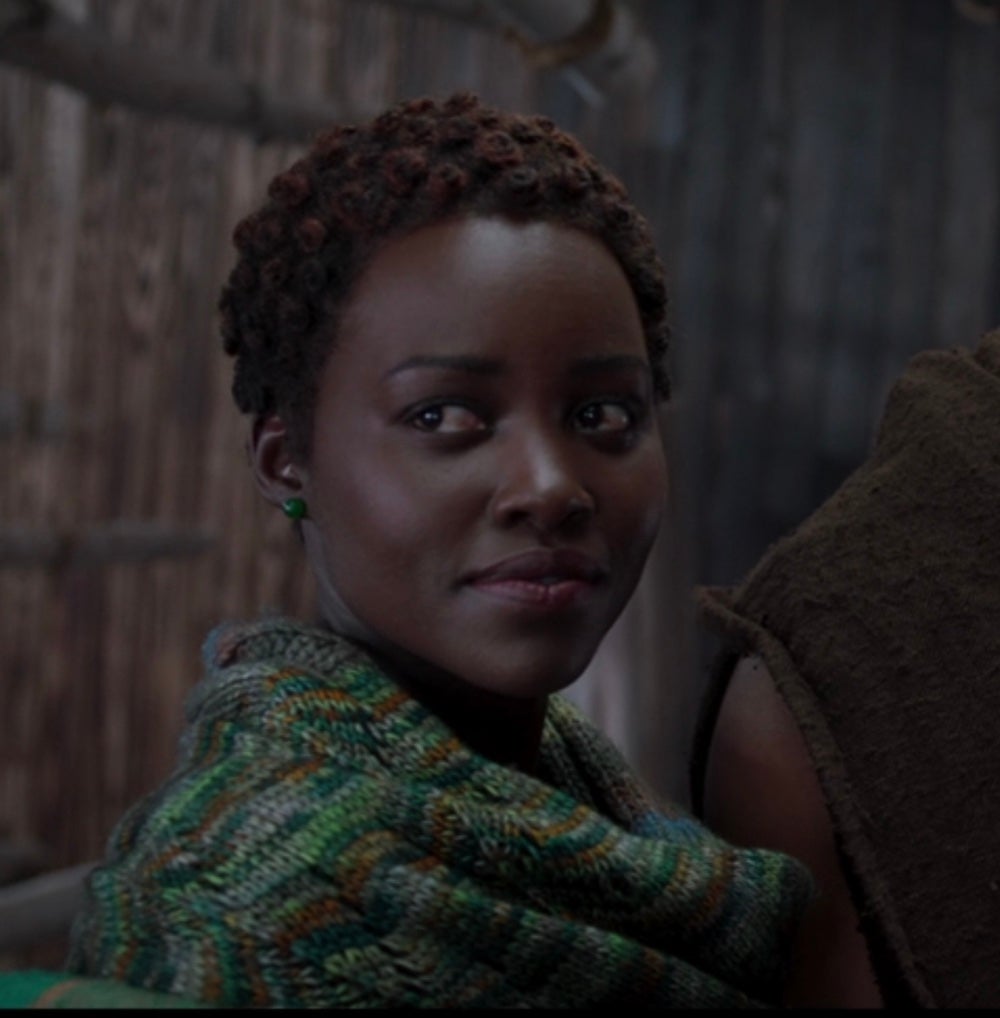
Nakia’s shawl
Black Panther introduces Nakia’s (Lupita Nyong’o) shawl, leading the designer to post the pattern.
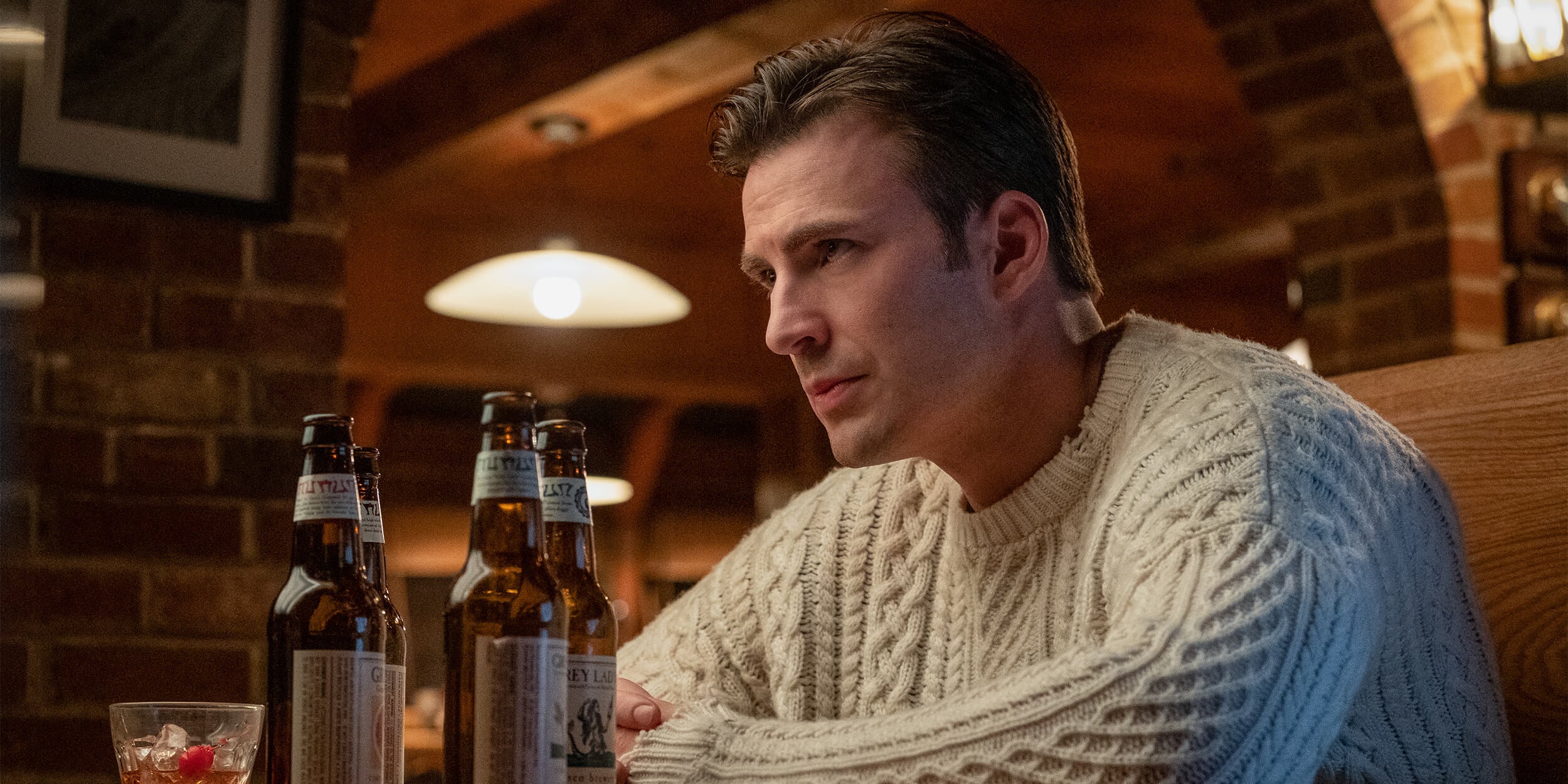
‘Knives Out’ sweater
Chris Evans’ Aran sweater inspires people to knit their own.
From the big screen to our screens
In the ’80s, we had newsletters. A couple of decades later, reverse-engineered patterns are all online. They might be shared on Ravelry, through Facebook groups, and on TikTok. The only difference between then and now? How those patterns are shared. And like Doctor Who, many of the designers of iconic knitwear are making the process even easier by sharing those patterns with fans.
Shortly after the release of Black Panther, Jeff Gillies, who created Nakia’s infinity shawl, published a free hand-knitted pattern on Ravelry. In the pattern’s instructions, Gillies highlighted another Ravelry user who helped Gillies, a machine knitter, translate his shawl so that it could be made by hand. Jenn Monahan, who made the shawls worn by Beth and Jo March in 2019’s Little Women, posted her patterns to Ravelry and is donating the proceeds she receives from sales to charity.
In February 2020, Harry Styles wore a JW Anderson patchwork cardigan during a rehearsal for his appearance on The Today Show. He might not actually have worn the cardigan on The Today Show, but it eclipsed Styles’ actual performance. Purchasing the cardigan, according to Insider, would cost more than $1,560, so fans got creative. They started to knit and crochet their own cardigans and shared the patterns on TikTok, which has become a popular avenue for sharing crochet patterns during the pandemic; some of these crafters had never made anything before. By July, JW Anderson founder Jonathan Anderson released the pattern (which was designed by knitwear designer Ruth Herring) for free and told fans that “I am so impressed and incredibly humbled by this trend and everyone knitting the cardigan.”
Charlie Rieder, a tutor who’s been crocheting for about a year-and-a-half, didn’t really consider making pop culture-affiliated knitwear until Styles wore his patchwork cardigan.
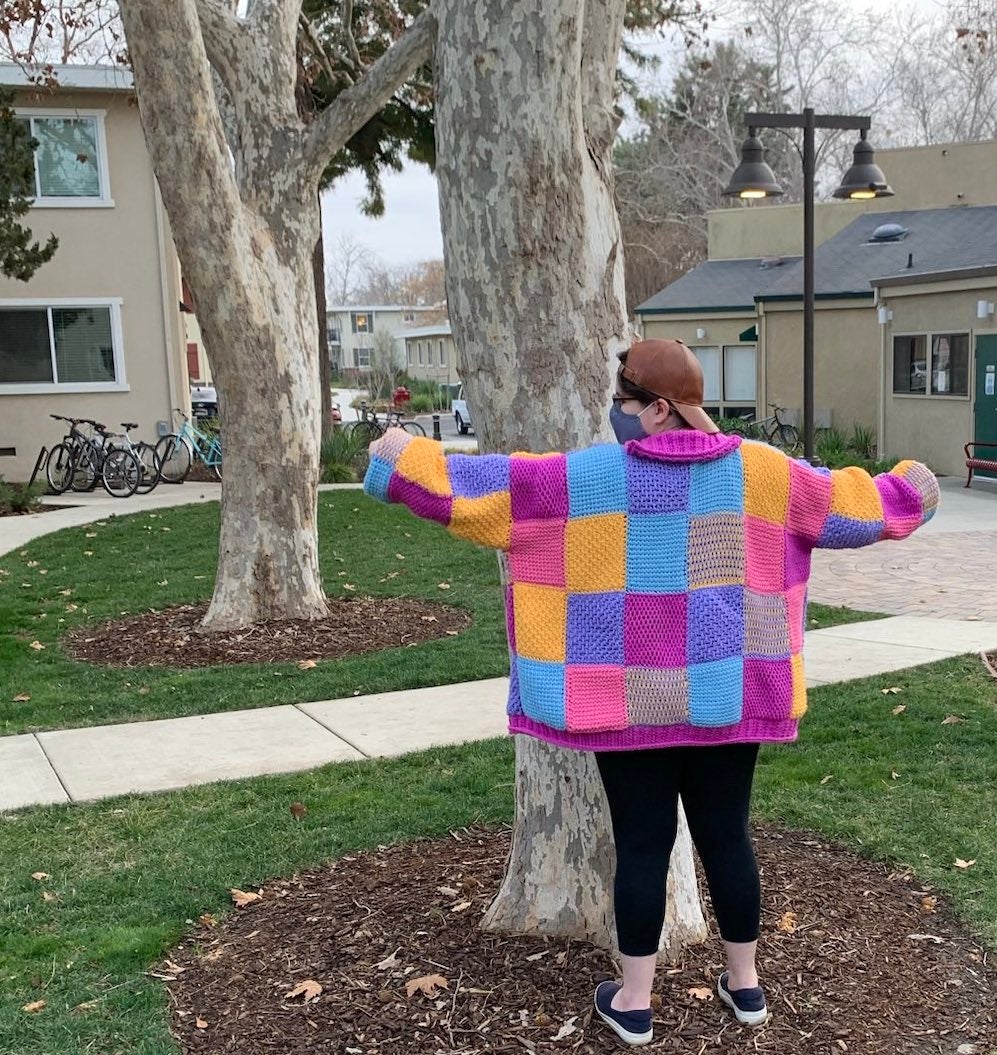
“In the video JW Anderson released to go with the pattern, they said the inspiration was old-fashioned toys, and that really spoke to me,” they told the Daily Dot. “I also just like making patchwork cardigans—making a bunch of individual pieces and assembling them offers a lot of flexibility, and it was easy enough to try it on as I went and adjust. It reminds me a lot of modular origami in that way. It’s like making your own building blocks, and then assembling them.”
A similar fervor spread around Taylor Swift’s white cardigan over the summer. The cardigan fittingly featured in Swift’s music video for “cardigan,” and as part of folklore, Swift’s first surprise album of 2020, Swift sold that cardigan in her official store. It only took days for fans to start making their own, and Lion Brand soon released its own pattern for the Taylor Swift cardigan. Someone on Etsy is even selling versions of both Styles’ and Swift’s cardigans for cats.
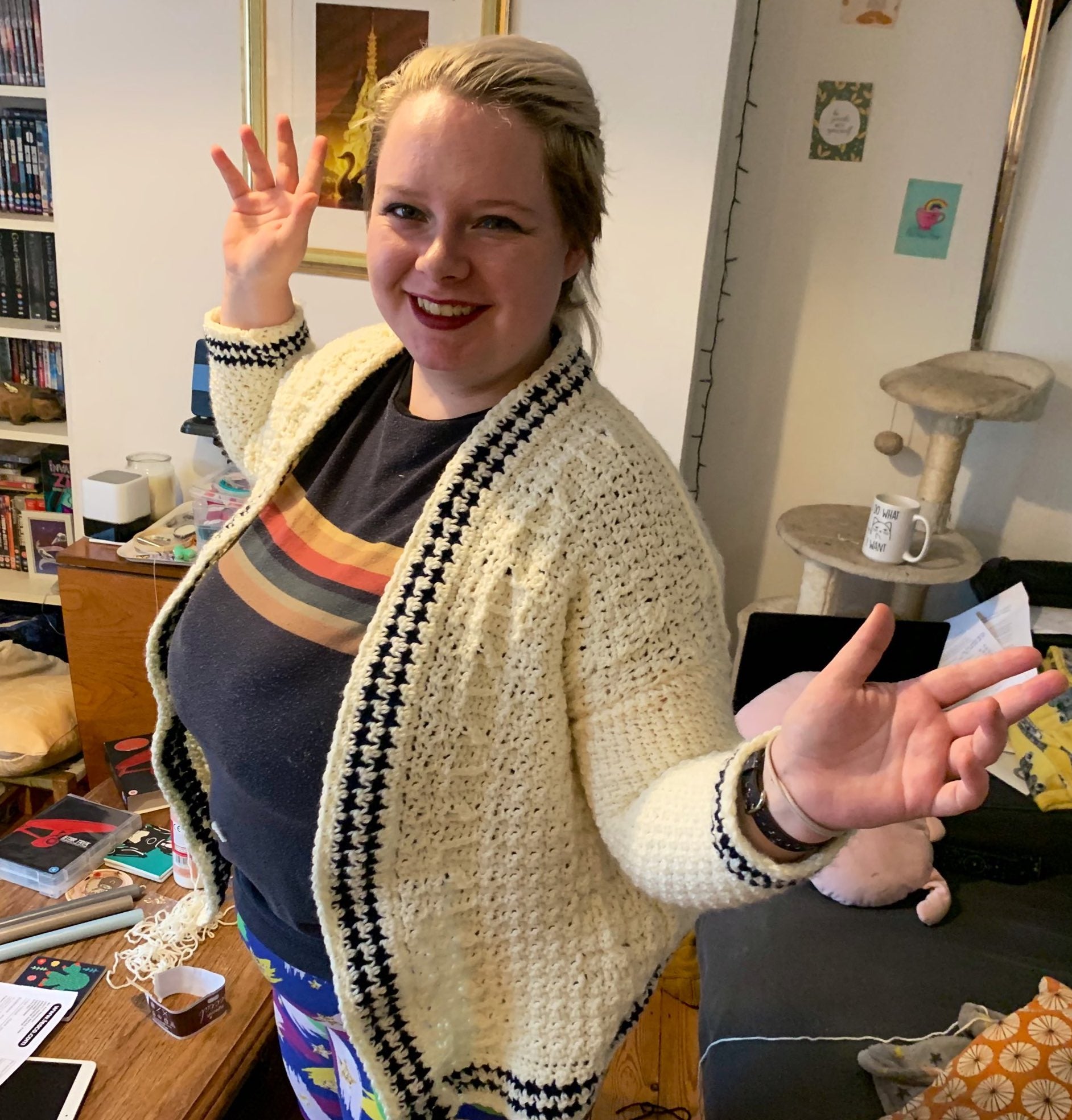
“I think the connection to folklore had a lot to do with [the cardigan’s popularity], especially as it was an unexpected, spontaneous source of joy in a year where very little unexpected joy was happening,” Phoenix, who crocheted their own Taylor Swift cardigan after the official one proved to be too expensive, told the Daily Dot. “I think that a lot of people have been looking for comfort this year, too, and there’s something hygge-ish about a big cozy cardigan which was a massive draw for me.”
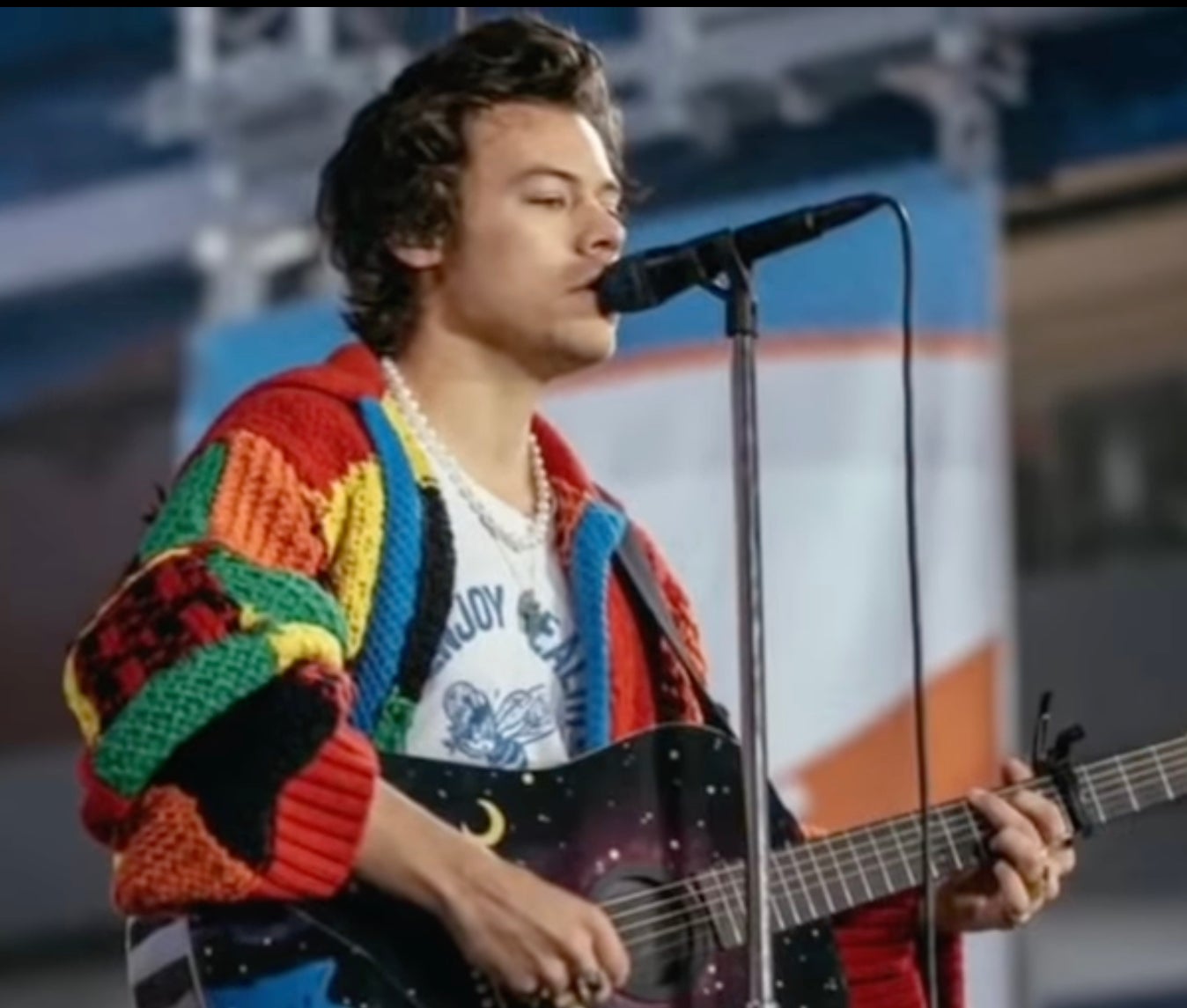
Harry Styles’ cardigan
Harry Styles wears a multicolored patchwork cardigan while rehearsing for The Today Show.
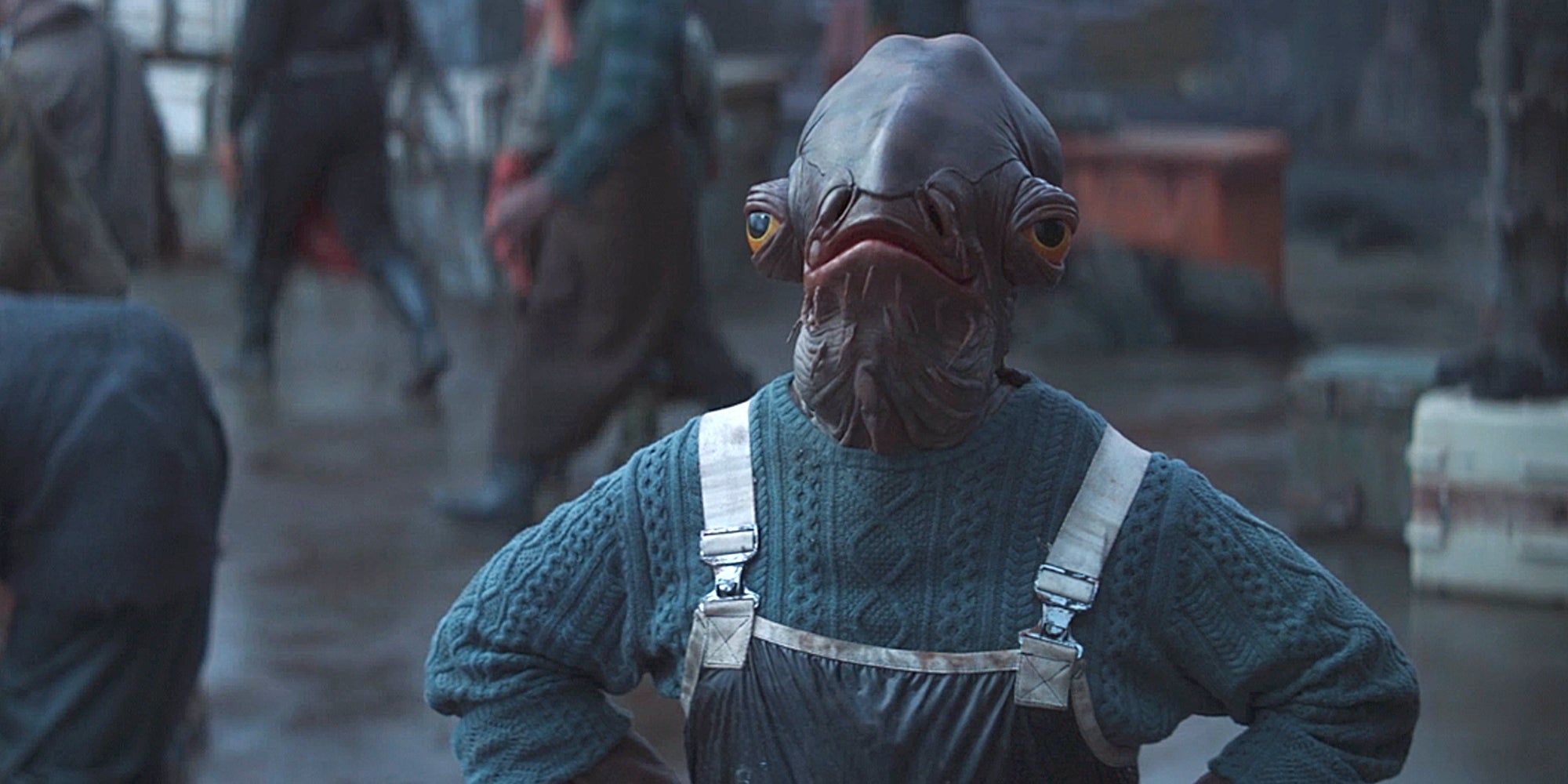
A Mon Calamari dock worker sports a sweater
The Mandalorian properly introduces knitwear to the Star Wars universe.
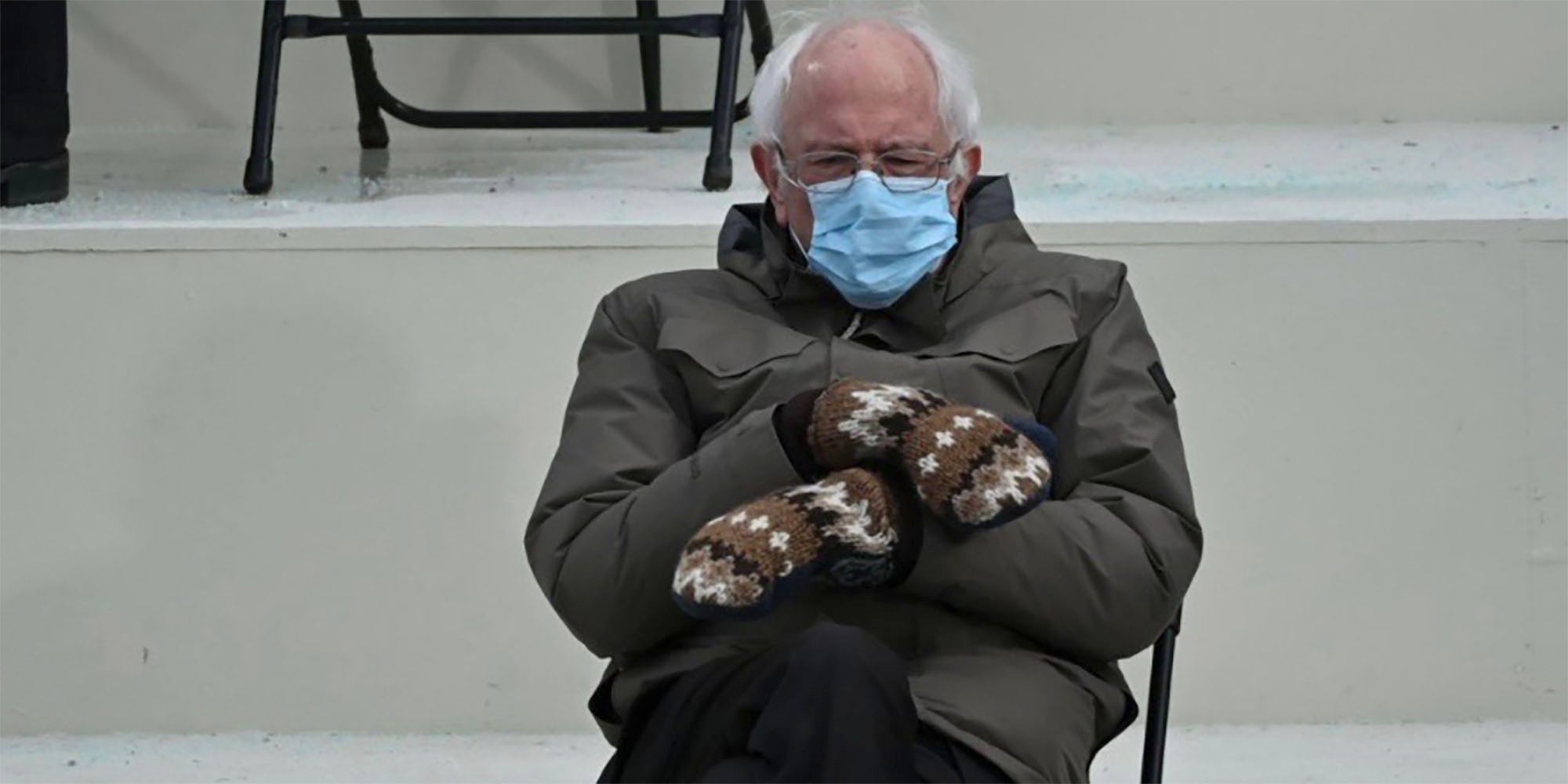
Bernie Sanders’ mittens
Sanders’ mittens go viral (again), leading to dozens of patterns being posted on Ravelry.
A decade or two ago, Harry Potter was arguably the biggest knitwear-friendly property, although for many Harry Potter fans, their relationship with the series is a lot more complicated now. But for its successor, look no further than Outlander. Starz’s adaptation of Diana Gabaldon’s fantasy novels took fans to the 18th-century Scottish highlands, and amid all of its period garb, the knitwear became one of its biggest stars after Caitríona Balfe and Sam Heughan. According to costume designer Terry Dresbach, who used the knitwear to help to solve the practical problem of including provocative outfits on the show, the “little shrugs and shawls help to cover [Claire, Outlander’s heroine] up and keep her warm.” (Some of the knitwear was made by local Scottish knitters while others were purchased on Etsy.)
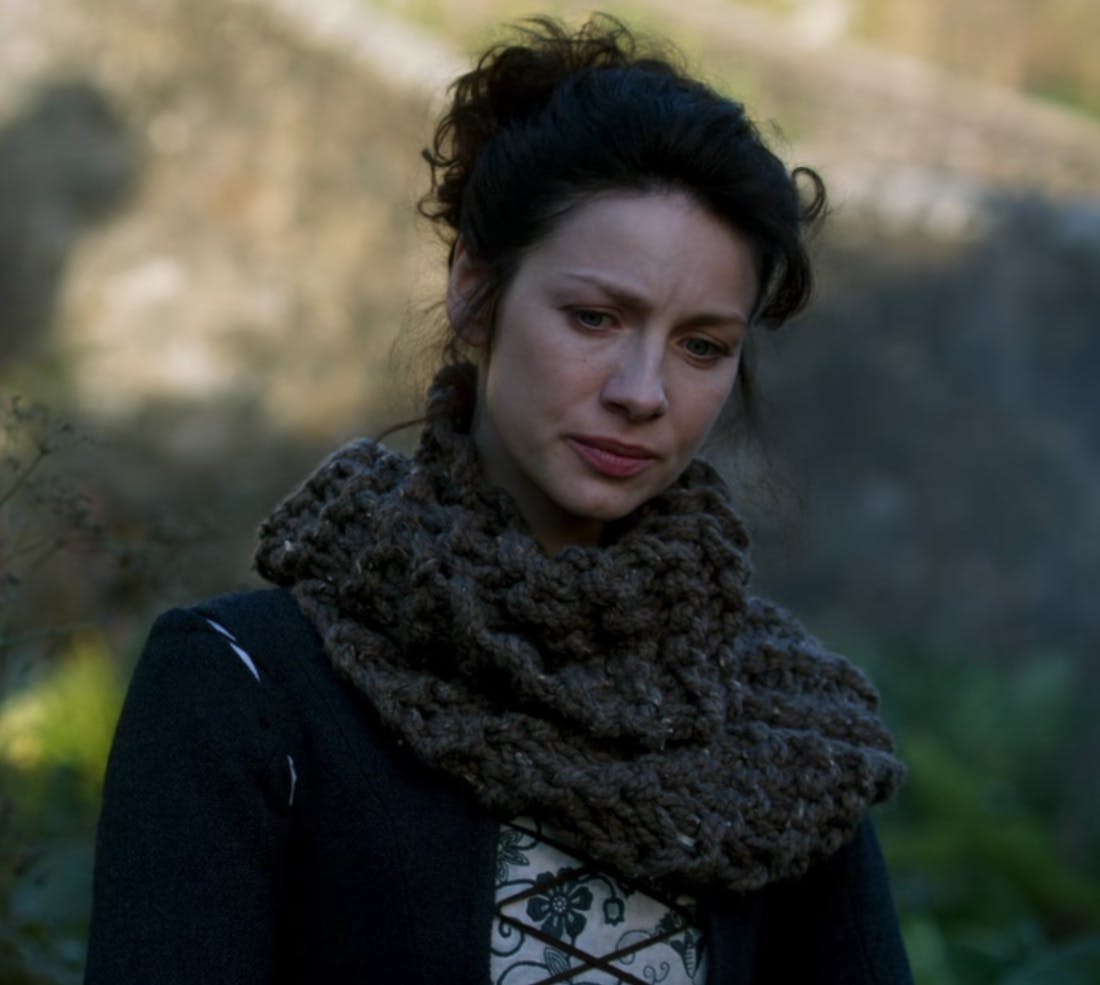
“I watched a little bit of Outlander and I was so struck by the knitting on the show,” the actress Kat Dennings said in a November 2019 appearance on Ellen. “This woman, this beautiful actress, I think her name is Caitríona Balfe. She’s wearing this cowl, it’s called a cowl…So I paused it, I took photos, and I was like, I’m gonna make this cowl. And I Googled it and, turns out, I’m not alone. Outlander knits is like a whole community.”
Sandie Russo, who’s been designing knitwear for about 15 years (and has both designed clothing and knitted for even longer), first got into Gabaldon’s series in 1992 after her daughter brought Outlander home for them to read. She’s been participating in Outlander forums and attending events well before the series aired, and when Starz first greenlit the series, social media helped keep her and other fans abreast of production. But when the third episode aired, Russo was inundated with requests to make Claire’s bulky cowl.
While she made some of those cowls and later many of the other items that appeared on Outlander, she also wrote down the patterns to sell; the two most popular items are a shawl Claire wears in season 1 and men’s Scottish tams (a traditional Scottish hat). And she also started two Outlander Knitters groups: one on Facebook, the other on Ravelry.
While the groups are definitely more active whenever the show is airing, the “droughtlander,” as Russo put it, still allows fans to discuss both knitting and Outlander’s knitwear. Between many people picking up knitting in quarantine along with starting to watch Outlander, Russo’s groups are among the groups who’ve seen their membership numbers increase during the pandemic.
“Outlander fans are a unique group of fans,” Russo explained to the Daily Dot. “They love the story of Jamie and Claire. And by knitting the shawls and hats and mitts, etc., it helps them to feel closer to their favorite show/books/characters. So it’s really been Outlander fans either rediscovering knitting or wanting to learn to knit because of the TV show.”
The mechanics of reverse-engineered knitwear
There’s no one right way to reverse-engineer a pattern, regardless of whether you’re designing something to knit or crochet. But to start, it’s usually a good idea to have a reference point of what you want to make on-hand.
When Russo puts together a pattern, she’ll pour over the photos and rewatch Outlander multiple times. She takes notes and knits a sample before photographing it with both a mannequin and a model. She’s also “been fortunate to see quite a few of the costumes and knitwear in person, which is very helpful.”
Multiple angles of Chris Evans’ Knives Out sweater and an open-source program called Stitch Fiddle helped Shaffer reproduce the five-cable panel. Shaffer would then knit swatches (or small squares knitted used to gauge measurements based on factors like yarn weight or how tight a stitch is) to check her work. While Shaffer started designing the pattern in December 2019, she wrote most of it during the early months of the pandemic after being furloughed at her previous job.
For Bryan, who is in the midst of designing her own version of a star yoke Schitt’s Creek sweater that David Rose (Daniel Levy) wears in the show’s third season, it involved some big design changes. She wasn’t a fan of how the seams on the sweater’s shoulders disrupted the pattern, and she wanted to set that right for herself. Her process included adapting a sweater that was likely machine-knitted to something that can be knitted by hand—not to mention using a lighter yarn than the original. And to make the pattern more inclusive, that means more charts for different sizes.
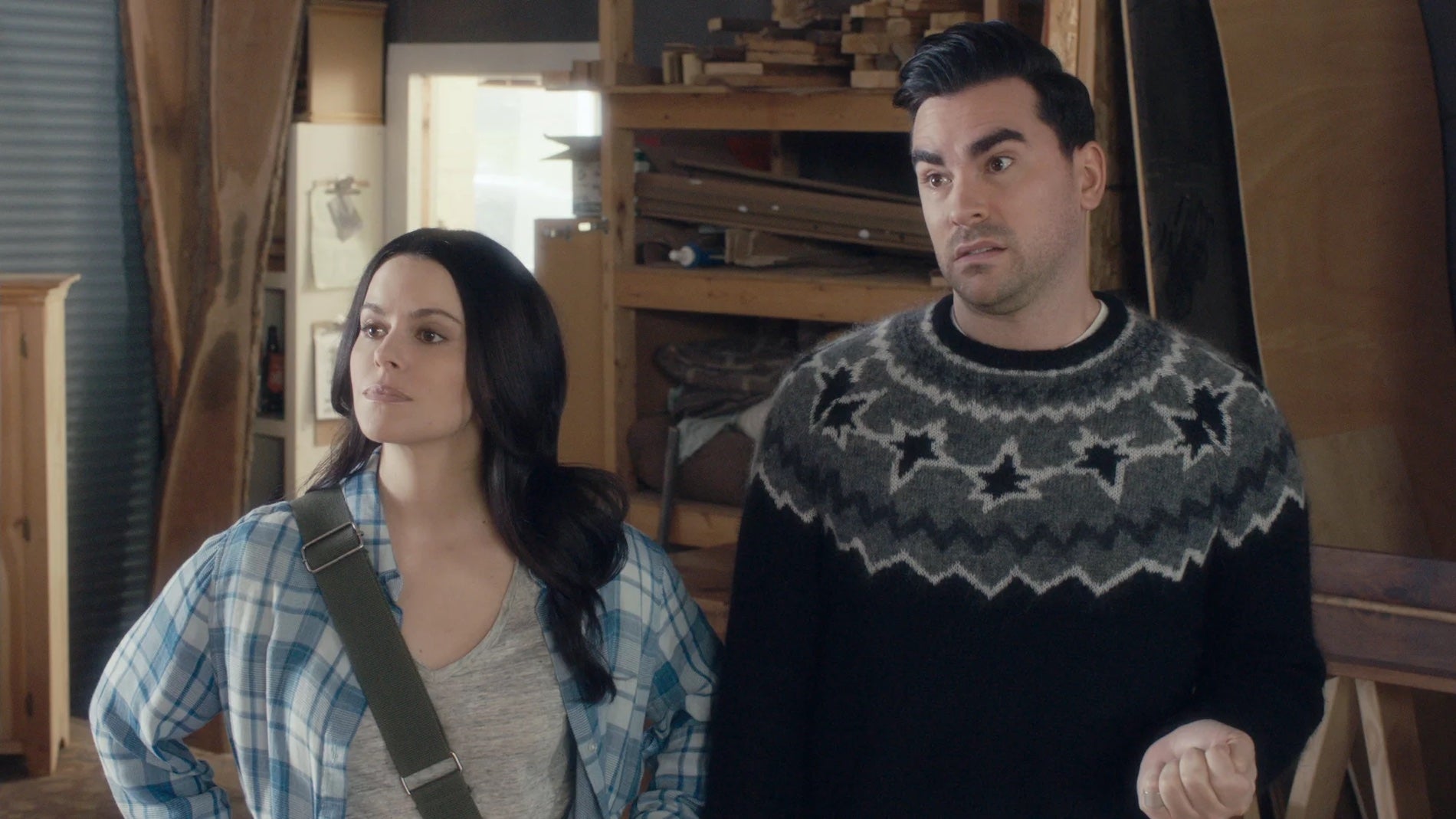
“My starting point is to get a colorwork pattern repeat that maintains the same sort of style as the original, but doesn’t necessarily match the original exactly,” Bryan said. “From there, I’ll test knit a sample of the colorwork to make sure I like how it comes out, make any tweaks, and then take a pattern blank (basically, the barebones formula of a sweater pattern), plug in all the things I want to customize, say a prayer, and knit a full test sweater.”
Rieder also adapted the Harry Styles cardigan to suit their own needs. They used a crocheting technique called Tunisian crochet to make it easier for them to sew everything together. But they also wanted to adhere closer to the actual texture of the cardigan, noting that “I wanted mine to have each square be a different stitch. I came up with the color palette and selected the stitches for each square myself, and arranged them on the sweater myself.”
Gray had a big task on her hands, and not just because her books covered more patterns. She had to make sure she included the staple pieces of knitwear (such as the Hogwarts scarves and the Weasley sweater). But when Gray was coming up with what else she wanted to include, she watched the films, took lots of notes, created initial sketches, and recruited other designers she believed would be best suited to join her in creating patterns. Those patterns also had to include a wide variety of size and skill levels and be interesting enough that it would make a reader want to create everything in the book, not just one or two patterns.
The rewards
Whether you’re designing reverse-engineered knitwear, making it, or both, it’s no question that it’s a lot of work; it might even be more than it’s worth. It can be expensive, especially if you use natural fibers over acrylic yarn. It might cost more to make one than it would be to buy one. In the case of Harry Potter and Doctor Who, official merchandise of those items already exist, and for other items like the Knives Out sweater, it’s possible to find a similar version online. For many knitters and crocheters, there are still plenty of benefits to doing it yourself.
Bryan took on recreating the Schitt’s Creek sweater because the yoke annoyed her. But other factors came into play: It was an unattainable designer sweater, unavailable, and it only had a limited size range. Making it herself made more sense to her, which gave her a greater appreciation for what knitwear designers do. “Really,” Bryan said, “I think pattern designers should be charging more!”
In Shaffer’s case, it showed what was possible. She still hasn’t finished knitting her own Knives Out sweater, but dozens of people have already knitted the sweater for themselves. Some of them hadn’t even waited for Shaffer to finish the pattern before casting on, and one person told her that their grandmother made two Knives Out sweaters before Christmas last year.
“I started out making the pattern just to test my skills and to see if I could, so I was surprised and a little alarmed when knitters started casting on without a completed pattern!” Shaffer said. “Even now, the smaller sizes are still only correct in theory and it’s unclear how much yarn the pattern actually takes. However, I’ve been thrilled to see other knitters make the pattern their own by using different yarn weights and colors.”
But even before anyone might see the end result, sometimes the effort alone is a reward in and of itself.
“Knitters knit because we love the process,” Gray said. “It’s not a particularly fast craft, and good yarn can be pricey, so we don’t do it because it’s cheaper to knit something rather than buy it. For me, if it’s one of my own designs, it’s the satisfaction of taking an idea in my brain, going through the sketching, doing all the math, choosing my materials, then seeing it come to life on my needles.”


